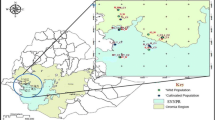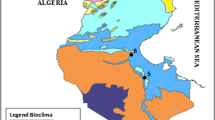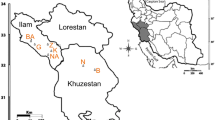Abstract
Dioscorea trifida L. (Dioscoreaceae) is among the economically most important cultivated Amerindian yam species, whose origin and domestication are still unresolved issues. In order to estimate the genetic diversity maintained by traditional farmers in Brazil, 53 accessions of D. trifida from 11 municipalities in the states of São Paulo, Santa Catarina, Mato Grosso and Amazonas were characterized on the basis of eight Simple Sequence Repeats (SSR) and 16 Inter Simple Sequence Repeats (ISSR) markers. The level of polymorphism among the accessions was high, 95 % for SSR and 75.8 % for ISSR. The SSR marker showed higher discrimination power among accessions compared to ISSR, with D parameter values of 0.79 and 0.44, respectively. Although SSR and ISSR markers led to dendrograms with different topologies, both separated the accessions into three main groups: I—Ubatuba-SP; II—Iguape-SP and Santa Catarina; and III—Mato Grosso. The accessions from Amazonas State were classified in group II with SSR and in a separate group with ISSR. Bayesian and principal coordinate analyzes conducted with both molecular markers corroborated the classification into three main groups. Higher variation was found within groups in the AMOVA analysis for both markers (66.5 and 60.6 % for ISSR and SSR, respectively), and higher Shannon diversity index was found for group II with SSR. Significant but low correlations were found between genetic and geographic distances (r = 0.08; p = 0.0007 for SSR and r = 0.16; p = 0.0002 for ISSR). Therefore, results from both markers showed a slight spatially structured genetic diversity in D. trifida accessions maintained by small traditional farmers in Brazil.




Similar content being viewed by others
References
Arruda R (1999) “Populações tradicionais” e a proteção dos recursos naturais em unidades de conservação. Ambient Soc 5:79–252
Ayensu ES, Coursey DG (1972) Guinea yams: the botany, ethnobotany, use and possible future of yams in West Africa. Econ Bot 26:301–318
Badfar-Chaleshtori S, Shiran B, Kohgard M, Mommeni H, Hafizi A, Khodambashi M, Mirakhorli N, Sorkheh K (2012) Assessment of genetic diversity and structure of Imperial Crown (Fritillaria imperialis L.) populations in the Zagros region of Iran using AFLP, ISSR and RAPD markers and implications for its conservation. Biochem Syst Ecol 42:35–48
Belaj A, Satovic Z, Cipriani G, Baldoni L, Testolin R, Rallo L, Trujillo I (2003) Comparative study of the discriminating capacity of RAPD, AFLP and SSR markers and their effectiveness in establishing genetic relationships in olive. Theor Appl Genet 107:736–744
Biswas MK, Xu Q, Deng X (2010) Utility of RAPD, ISSR, IRAP and REMAP markers for the genetic analysis of Citrus spp. Sci Hortic 124:254–261
Bousalem M, Amau G, Hochu I, Amolin R, Viader V, Santoni S, David J (2006) Microsatellite segregation analysis and cytogenetic evidence for tetrasomic inheritance in the American yam Dioscorea trifida and a new basic chromosome number in the Dioscoreae. Theor Appl Genet 113:439–451
Bousalem M, Viader V, Mariac C, Gomez R, Hochu I, Santoni S, David J (2010) Evidence of diploidy in the wild Amerindian yam, a putative progenitor of the endangered species Dioscorea trifida (Dioscoreaceae). Genome 53:371–383
Bressan EA, Veasey EA, Peroni N, Felipim AP, Santos KMP (2005) Collecting yam (Dioscorea spp.) and sweet potato (Ipomoea batatas) germplasm in traditional agriculture small-holdings in the Vale do Ribeira, São Paulo, Brazil. Plant Genet Resour Newsl 144:8–13
Bressan EA, Briner Neto T, Zucchi MI, Rabello RJ, Veasey EA (2011) Morphological variation and isozyme diversity in Dioscorea alata L. landraces from Vale do Ribeira, Brazil. Sci Agric 68:494–502
Clement CR (1999) 1492 and the loss of Amazonian crop genetic resources. II. Crop biogeography at contact. Econ Bot 53:203–216
Clement CR, Cristo-Araújo M, D’Eeckenbrugge GC, Pereira AA, Picanço-Rodrigues D (2010) Origin and domestication of native Amazonian crops. Diversity 2:72–106
Coursey DG (1976) The origin and domestication of yams in Africa. In: Harlan JR, De Wet JMJ, Stemler ABL (eds) Origin of African plant domestication. Mouton Hague, Netherlands, pp 383–408
Creste S, Tulmann NA, Figueira A (2001) Detection of single sequence repeat polymorphisms in denaturing polyacrylamide sequencing gels by silver staining. Plant Mol Biol Rep 19:299–306
Degras L (1993) The yam: a tropical root crop. Macmillan Press, London
Dickau R, Ranere AJ, Cooke RG (2007) Starch grain evidence for the preceramic dispersals of maize and root crops into tropical dry and humid forests of Panama. Proc Natl Acad Sci 104:3651–3656
Doyle JJ, Doyle JL (1990) Isolation of plant DNA from fresh tissue. Focus 12:13–15
Evanno G, Regnaut S, Goudet J (2005) Detecting the number of clusters of individuals using the software STRUCTURE: a simulation study. Mol Ecol 14:2611–2620
Falush D, Stephens M, Pritchard JK (2007) Inference of population structure using multilocus genotype data: dominant markers and null alleles. Mol Ecol Notes 7:574–578
Francisco-Ortega J, Santos-Guerra A, Kim SC, Crawford DJ (2000) Plant genetic diversity in the Canary Islands: a conservation perspective. Am J Bot 87:909–919
Gaudeul M, Taberlet P, Till-bottraud I (2000) Genetic diversity in an endangered alpine plant, Eryngium alpinum L. (Apiaceae), inferred from amplified fragment length polymorphism markers. Mol Ecol 9:1625–1637
Hamrick JL, Godt MJW (1989) Allozyme diversity in plant species. In: Brown AHD, Clegg MT, Kahler AL, Weir BS (eds) Plant population genetics, breeding and genetic resources. Sinauer Associates, Massachusetts, pp 43–46
Hamrick JL, Godt MJW (1996) Conservation genetics of endemic plant species. In: Avise JC, Hamrick JL (eds) Conservation genetics: case histories from nature. Chapman and Hall, New York, pp 281–304
Hamrick JL, Godt MJ, Murawski DA, Loveless MD (1991) Correlations between species and allozyme diversity: implications for conservation biology. In: Falk DA, Holsinger KE (eds) Genetics and conservation of rare plants. Oxford University Press, New York, pp 75–86
Hochu I, Santoni S, Bousalem M (2006) Isolation, characterization and cross-species amplification of microsatellite DNA loci in the tropical American yam Dioscorea trifida. Mol Ecol 6:137–140
Huang JC, Sun M (2000) Fluorescein PAGE analysis of microsatellite-primed PCR: a fast and efficient approach for genomic fingerprinting. Biotechniques 28:1069–1072
Ladeira MI (1992) “O caminhar sob a luz”-o território Mbyá à beira do Oceano. Pontifícia Universidade Católica de São Paulo, Dissertation
Lebot V (2009) Tropical root and tuber crops: cassava, sweet potato, yams and aroids. CABI, London
Mantel N (1967) The detection of disease clustering and a generalized regression approach. Cancer Res 27:202–209
Mattioni C, Casasoli M, Gonzalez M (2002) Comparison of ISSR and RAPD markers to characterize three Chilean Nothofagus species. Theor Appl Gent 104:1064–1070
McGregor CE, Lambert CA, Greyling MM, Louw JH, Warnich L (2000) A comparative assessment of DNA fingerprinting techniques (RAPD, ISSR, AFLP and SSR) in tetraploid potato (Solanum tuberosum L.) germplasm. Euphytica 113:135–144
Mengesha WA, Demissew S, Fay MF, Smith RJ, Nordal I, Wilkin P (2013) Genetic diversity and population structure of Guinea yams and their wild relatives in South and South West Ethiopia as revealed by microsatellite markers. Genet Resour Crop Evol 60:529–541
Mignouna HD, Abang MM, Fagbemi SA (2003) A comparative assessment of molecular marker assays (AFLP, RAPD and SSR) for white yam (Dioscorea rotundata) germplasm characterization. Ann Appl Biol 142:269–276
Montaldo A (1991) Cultivo de raíces y tubérculos tropicales. Instituto Interamericano de Ciências Agrícolas de la OEA, Lima
Odu BO, Asiedu R, JA Hughes, Shoyinka SA, Oladiran OA (2004) Identification of resistance to yam mosaic vírus (YMV), genus Potyvirus in white Guinea yam (Dioscorea rotundata Poir.). Field Crop Res 89:97–195
Oliveira EJ, Pádua JG, Zucchi MI, Vencovsky R, Vieira LC (2006) Origin, evolution and genome distribution of microsatellites. Genet Mol Biol 29:294–307
Olsen KM (2004) SNPs, SSRs and inferences on cassava’s origin. Plant Mol Biol 56:517–526
Pedralli G (1998) Revisão taxonômica das espécies de Dioscoreaceae (R.Br.) Lindley da Cadeia do Espinhaço, Minas Gerais e Bahia, Brasil. Dissertation, University of São Paulo
Perrier X, Jacquemoud-Collet JP (2006) DARwin software. http://darwin.cirad.fr/darwin. Accessed 20 Nov 2011
Piperno DR, Ranere AJ, Holst I, Hansell P (2000) Starch grains reveal early root crop horticulture in the Panamanian tropical forest. Nature 407:894–897
Prevost A, Wilkinson MJ (1999) A new system of comparing PCR primers applied to ISSR fingerprinting of potato cultivars. Theor Appl Genet 98:107–112
Pritchard JK, Donnelly P (2001) Case-control studies of association in structured or admixed populations. Theor Popul Biol 60:227–237
Pritchard JK, Stephens M, Donnelly P (2000) Inference of population structure using multilocus genotype data. Genetics 155:945–959
Ramos-Escudero F, Santos-Buelga C, Pérez-Alonso JJ, Yáñes JA, Dueñas M (2010) HPLC-DAD-ESI/MS identification of anthocyanins in Dioscorea trifida L, yam tuber (purple sachapapa). Eur Food Res Technol 230:745–752
Reddy MP, Sarla N, Reddy EA (2002) Inter simple sequence repeat (ISSR) polymorphism and application plant breeding. Euphytica 128:9–17
Rogstad SH (1992) Saturated NaCl-CTAB solution as a means of field preservation of leaves for DNA analyses. Taxon 41:701–708
Rohlf FJ (1992) NTSYS-pc: numerical taxonomy and multivariate analysis system, version 1.70 (software). Stony Brook, New York
Schmitz PI, Gazzaneo M (1991) O que comia o Guarani pré-colonial. Rev Arqueol 6:89–105
Schneider S, Roessli D, Excoffier L (2000) Arlequin: software for population data analysis (Software). Genetic and Biometry laboratory of University of Geneva, Geneva
Siqueira MVBM (2011) Yam: a neglected and underutilized crop in Brazil. Hort Brasil 29:6–20
Siqueira MVBM, Queiroz-Silva JR, Bressan EA, Borges A, Pereira KJC, Pinto JG, Veasey EA (2009) Genetic characterization of cassava (Manihot esculenta) landraces in Brazil assessed with simple sequence repeats. Genet Mol Biol 32:104–110
Siqueira MVBM, Dequigiovanni G, Corazon-Guivin M, Feltran J, Veasey EA (2012) DNA fingerprinting of water yam (Dioscorea alata) cultivars in Brazil based on microsatellite markers. Hort Brasil 30:653–659
Stephens JM (2009) Cushcush – Dioscorea trifida L. http://edis.ifas.ufl.edu/mv057. Accessed 27 Dec 2009
Tessier C, David J, This P, Boursiquot J, Charrier A (1999) Optimizations of the choice of molecular markers for varietal identification in Vitis vinifera L. Theor Appl Genet 98:171–177
Tostain S, Scarcelli N, Brottier P, Marchand JL, Pham JL, Noyer JL (2006) Development of DNA microsatellite markers in tropical yam (Dioscorea sp.). Mol Ecol 6:173–175
Veasey EA, Borges A, Rosa MS, Queiroz-Silva JR, Bressan EA, Peroni N (2008) Genetic diversity in Brazilian sweetpotato (Ipomoea batatas (L.) Lam.) landraces assessed with microsatellites. Genet Mol Biol 31:725–733
Veasey EA, Monteiro MVB, Gomes LR, Nascimento WF, Ferreira AB, Silva MS, Silva EF, Ming LC, Peroni N, Santos AH (2010) Ocorrência e diversidade de espécies cultivadas do gênero Dioscorea em diversos agroecossistemas brasileiros. In: Ming LC, Amorozo MCM, Kffuri CW (eds) Agrobiodiversidade no Brasil: experiências e caminhos da pesquisa, 1st edn. NUPEEA, Recife, pp 45–74
Veasey EA, Bressan EA, Siqueira MVBM, Borges A, Queiroz-Silva JR, Pereira KJC, Recchia GH, Ming LC (2012) Genetic characterization of cassava (Manihot esculenta Crantz) and yam (Dioscorea trifida L.) landraces in swidden agriculture systems in Brazil. In: Gepts P, Famula TR, Bettinger RL, Brush SB, Damania AB, McGuire PE, Qualset CO (eds) Biodiversity in agriculture: domestication, evolution, and sustainability. Cambridge Univ. Press, New York, pp 344–360
Velez GA (1998) The chagra: collective patrimony of the indigenous Amazonian communities. Beyond Law 6:121–142
Vogel JM, Rafalski A, Powell W, Morgante M, Andre C, Hanafey M, Tingey SV (1996) Application of genetic diagnostics to plant genome analysis and plant breeding. HortScience 31:1107–1108
Wolfe AD (2000) ISSR protocols. http://www.biosci.ohio-state.edu/~awolfe/ISSR/protocols.ISSR.html. Accessed 18 May 2009
Wolfe AD (2005) ISSR techniques for evolutionary biology. Methods Enzymol 395:134–144
Wu Z, Leng C, Tao Z, Wei Y, Jiang C (2009) Genetic diversity of Dioscorea alata on ISSR analysis. Zhongguo Zhong Yao Za Zhi 34:3017–3020
Yeh FC, Yang RC, Boyle TBJ, Ye ZH, Mao JX (1997) POPGENE, the user-friendly shareware for population genetic analysis. Mol Biol Biotechnol Centre, Canadian, Edmonton
Zhou Y, Zhou C, Yao H, Liu Y, Tu R (2008) Amplification of ISSR markers in detection of genetic variation among Chinese yam (Dioscorea opposita Thunb.) cultivars. Life Sci J 5:6–12
Zietkiewicz E, Rafalski A, Labuda D (1994) Genome fingerprinting by simple sequence repeat (SSR)-anchored polymerase chain reaction amplification. Genomics 20:176–183
Acknowledgments
The authors would like to thank the researchers Nivaldo Peroni, Antônio Henrique dos Santos, Lin Chau Ming, Edson Ferreira da Silva, Marcos V.B.M. Siqueira and Almecina Balbino Ferreira for their assistance in this research and the agriculturists for their contributions in the field collecting and interviews. The authors would also wish to thank FAPESP (process no. 2007/04805-2) and CNPq for the financial support given to this study.
Author information
Authors and Affiliations
Corresponding author
Rights and permissions
About this article
Cite this article
Nascimento, W.F., Rodrigues, J.F., Koehler, S. et al. Spatially structured genetic diversity of the Amerindian yam (Dioscorea trifida L.) assessed by SSR and ISSR markers in Southern Brazil. Genet Resour Crop Evol 60, 2405–2420 (2013). https://doi.org/10.1007/s10722-013-0008-y
Received:
Accepted:
Published:
Issue Date:
DOI: https://doi.org/10.1007/s10722-013-0008-y




